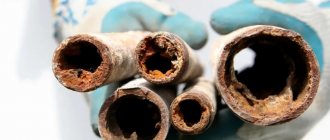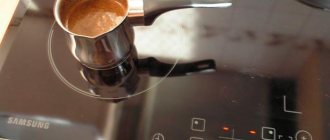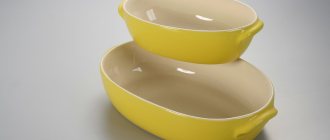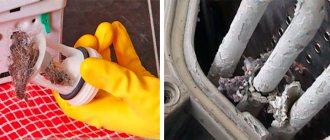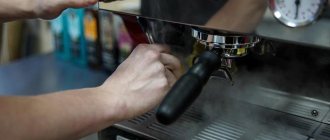Cleaning any coffee machine or coffee maker is a mandatory procedure during operation. Sooner or later, the device requires maintenance, and in order to prevent it from breaking down, owners need to know how to clean the coffee machine on their own. A coffee machine differs from a coffee maker in its set of functions, operating principle and design, but the cleaning methods for them are similar. In this article we will look at the most popular ways to properly clean a coffee machine.
Attention! Before cleaning the coffee machine, please read the instructions carefully, as... Much depends on the model and brand of the device.
How to descale a coffee machine
Manufacturers of coffee machines are trying to simplify the cleaning process, because you certainly don’t want to send this household appliance to a specialist after drinking a certain number of cups of coffee. It must be carried out according to the manufacturer's recommendations.
Attention ! If you do not remove the scale, problems will arise with the heating of the device. That is, the volume of liquid will gradually decrease, and the temperature of the finished drink will decrease. The frequency of the procedure also depends on the hardness of the water used.
Before you clean a carob coffee maker, geyser coffee maker, capsule or drip coffee maker, you should find out why you should do it at all. The reasons are as follows:
- Extending service life.
- Maximum efficient cooking.
- Optimal temperature.
- Minimum noise in the process.
You choose to repair your equipment or have it cleaned in a timely manner.
Causes of scale
The cause of limescale is the hardness salts CaCO3 and MgCO3 (salts of rare earth metals calcium and magnesium) that are poorly soluble in water. These compounds are formed by heating bicarbonates Ca(HCO3)2 and Mg(HCO3)2, which are part of natural water and decompose at temperatures above +40 ºС.
The reaction occurs:
Ca(HCO3)2 = CaCO3 + H2O + CO2;
Mg(HCO3)2 = MgCO3 + H2O + CO2.
If you install an ion exchange filter or a device that magnetizes water on the incoming water pipe, you can significantly reduce the deposition of hardness salts on heaters and extend the service life of not only the coffee maker, but also the boiler, kettle, washing machine and dishwasher.
Auto cleanup
Cleaning the coffee machine programmed by the manufacturer is a convenient function. This means that the user simply needs to follow the steps described in the instructions. And if it states that it is necessary to use a certain product, then it should be purchased. The cleaning process will take no more than 5 minutes, and if everything is done correctly, then there will be no trace of scale left.
It is useful to run the coffee machine decalcification program regularly, and if possible, even daily. Setting an automatic program is possible for a certain time, for example, at night. Such preventive cleaning will help to avoid the initial accumulation of scale, and therefore eliminate serious problems with the unit.
Before starting the auto-cleaning process, you should check the supply of decalcifier, if it is also supplied independently from a special cartridge in the housing.
Attention! It is worth understanding that this function is not available in all models of coffee machines, but only in quite expensive ones, so in most cases you will have to clean it yourself.
Action plan for most standard coffee machines with auto-clean function:
- Rinsing the water tank, removing grains.
- Pouring the product (pre-prepared solution) into the tank.
- Launch the auto-clean function.
- Rinsing the tank and hopper of the coffee machine with a stream of water.
- Start the cooking program. The first portion should be poured out.
What happens if cleaning is not carried out?
Some coffee machine owners accidentally or intentionally forget about preventive cleaning. This is fraught with the development of such unpleasant consequences:
- Unpleasant musty smell of coffee mixed with greasy stains.
- Cloudy dense sediment at the bottom of the cup.
- Adding loud sounds that were not there before.
- The coffee machine fails without the possibility of repair.
Prevention is the key to good and long-term operation of any equipment. If you ignore the manufacturer's advice, you will have to spend a lot of money on repairs.
Special means
Before descaling your coffee maker, you should decide what exactly to use for cleaning. Almost every major manufacturer of coffee machines offers their own branded products. Most often they are advised to buy them together with a coffee machine. It is safe to use a special product for a coffee machine, but many doubt how safe they are for humans.
The product must be prepared in a special way. It is not difficult to make the solution according to the instructions; it is in the instruction manual for the device itself and on the decalcifier. You cannot violate the proportions, otherwise you can harm both the device and your own health. You can make liquids for cleaning a coffee machine yourself, but before using them you should carefully read the algorithm.
Attention! If you need to prepare the product, you should use only clean water for dissolution, the same as for making coffee.
If you need to clean coffee oils, then the descaling agent will not cope with this; you need special tablets. The filter of the coffee machine and the entire brewing unit, on which oils and coffee particles are firmly deposited, require cleaning from time to time to remove coffee oils. Failure to do so may lead to clogging of the drain valve and subsequent repair of the device. There are also models with and without automatic filter cleaning.
Attention! The descaling program and the coffee oil cleaning program are two different types of cleaning and therefore require different products.
Common means and their features
To clean the coffee machine from scale and other contaminants, special cleaning products designed for this purpose, as well as improvised substances that have similar effectiveness, can be used.
Use of special equipment
Coffee machine manufacturers usually indicate cleaning products that can be used for a particular model, along with step-by-step instructions. The most popular of them are the following.
EcoDecalk by DeLonghi
Available in liquid form, a bottle with a dispenser. The main component is citric acid. Suitable for all types of coffee machines.
| Advantages | Flaws |
| Completely natural composition | High cost (about 2000 rubles) |
| Quite a large volume | |
| Does not cause damage to machine elements | |
| Does not harm the environment |
The cleaning product protects heating elements from premature deterioration and gently removes plaque. It washes out well with warm water and does not cause the formation of foam.
Krups
Tablets with active ingredients are suitable for coffee machines of the same brand, but according to experts, they can be used in absolutely any coffee maker.
| Advantages | Flaws |
| Removes not only scale, but also coffee oil | High price (about 1600 rubles for 10 tablets) |
| Can be used for prevention | |
| Dissolves quickly and leaves no odor in the car |
This product is ideal when using hard tap water. In 5-7 minutes, any plaque dissolves and is removed naturally, and the coffee machine works like new.
TOP House
German liquid for cleaning coffee machines combines all the advantages and has no disadvantages. Suitable for all models of coffee makers, carefully removes plaque and has a protective effect against corrosion. A convenient dispenser allows you to measure the required amount of product. The cost is about 300 rubles, which is very economical for any budget.
Available means
You can also descale your coffee machine using conventional means available in the kitchen. If you pay attention to the composition of expensive specialized products, almost all of them contain the main substance – citric acid.
The following products can also be used as cleaners:
Soda Ash
It is dissolved in warm water and poured into the machine, after which coffee without beans is prepared.
Regular soda
It copes well with greasy deposits from coffee and is suitable for manual cleaning of individual removable components.
Coarse salt
Abrasiveness cleans even the most complex contaminants, does not harm the metal and does not provoke the development of corrosion.
Such products can be used for preventive cleaning, and it is recommended to carry out planned activities with a special product.
Cleaning tablets
Using special tablets, cleaning is carried out as efficiently as possible. They are pre-dissolved in water in certain proportions (more details can be found on the packaging). 1 tablet is used for 1 cleaning session. Cleaning tablets can be produced:
- From scale.
- To remove coffee oils.
Let us remind you once again that they are not interchangeable and are used for specific purposes. On sale you can find branded (more expensive) and universal ones. What you choose is up to you, but experts do not recommend saving on cleaning products for expensive coffee machines.
Procedure
Instructions on how to clean a Krups coffee machine with a tablet:
- Turn on the coffee maker and press the button to go to the service menu.
- Activate the cleaning function - the corresponding indicator on the display will flash.
- If you are using universal tablets that need to be dissolved, then liquid is taken into the container and 1 tablet is placed. If a cleaning agent is used, it is placed in the compartment for ground coffee.
- Once the cleaning process begins, it will take place in several stages, each lasting 8 minutes.
If a signal appears on the display that it is necessary to add water and remove liquid from the pan, you need to fill the container again to wash away any remaining chemicals. After this, the coffee machine is ready for use.
Cleaning the coffee machine from scale with citric acid
Citric acid is the most affordable product used to descale coffee machines. When implementing the method, it is important to maintain the proportions of the acid, no more than 3-4 tsp per cycle. The following instructions are useful for cleaning:
- Turn off the device.
- Remove the water tank and rinse it several times under running water.
- Pour in water with citric acid. You can find out exactly how much water you need from the coffee machine instructions. The liquid should be at room temperature.
- Run 2-3 or more coffee brewing modes until the water tank is empty.
- Next, you need to remove the water tank and rinse it, pour clean water into the tank.
- Run at least 2 coffee brewing cycles in a row.
Attention! Some experts do not recommend using citric acid to clean coffee machines, because... it may damage parts. Be careful and, if possible, give preference to special means.
How to increase the interval between cleanings
Using bottled water can significantly lengthen the intervals between cleaning the unit.
In order to resort to cleaning the device less often, you should remember some rules for its operation:
- Fill the tank with filtered water. In some models it is built-in, however, this does not mean that the quality of water can be neglected. It is worth purchasing a filter in the form of a jug or installing a system on the kitchen faucet. To make life easier, you can purchase bottled water, it does not form scale. This simple technique will allow you to resort to cleaning the coffee machine approximately once every six months.
- Use quality coffee.
- If the device signals the need for cleaning with an indicator of the corresponding color, it is not advisable to ignore it - you just need to start the process with ordinary water, without adding special products.
- The cappuccino maker and coffee compartment should be washed regularly, since the organic environment is a breeding ground for bacteria.
Using high-quality coffee extends the life of the coffee maker
When purchasing kitchen appliances, everyone hopes for its long service life. In order for your coffee machine to delight you with the pleasant taste of your favorite drink, it should be looked after on a regular basis. After all, scale on the boiler, stagnation of milk residues in the cappuccino maker, clogging of the coffee compartment - all this not only affects the quality of the coffee, but sooner or later will cause the unit to break down.
It will be interesting to learn 7 recipes for making coffee in a coffee machine and read the rating of bean coffee brands for coffee machines.
With proper care of your coffee machine, it will constantly delight you with a tasty, aromatic drink.
Cleaning the cappuccino maker
If the machine has a cappuccino preparation function, then the cappuccino maker in the coffee machine must also be cleaned periodically. Residues of milk and cream dry out and clog the milk supply hose. All you need to do is run clean water or water with a special cleaning agent through the foaming system. To do this, instead of a container with milk, place a container of water and turn on the hot foam preparation mode. The process should be continued until clear water comes out of the cappuccino maker. If you used a cleaning agent, do not forget to do several runs with clean water after the procedure.
You can use another method: lower the hose into a container with boiling water and turn on the steam supply.
Signs of a clogged coffee maker
When using water containing hardness salts, scale will inevitably form in the coffee maker. Both simple drip and capsule or carob coffee makers are susceptible to clogging.
The more bends and smaller the diameter of the tubes for the passage of water in the coffee maker, the greater the likelihood of scale formation. Lime scale particles clog water flow channels.
Not all coffee makers are equipped with a built-in indicator (a counter for the number of cups of coffee brewed), so you need to be able to recognize signs of limescale deposits inside the machine:
- It takes longer to prepare one serving of drink than before;
- if the tube and outlet are clogged, the stream of ready-made coffee becomes thin, causing the cup to take longer to fill;
- the taste of the drink has deteriorated;
- there is a foreign smell;
- the operating device began to make unusual sounds;
- a light gray sediment is visible in the cup;
- Electricity consumption has increased while the coffee maker is operating.
According to repair specialists, boiler-type capsule and carob coffee makers are most susceptible to heater overgrowth and tube clogging. In devices with a thermoblock, water does not stagnate, and the process of scale formation proceeds more slowly.
If limescale deposits have appeared, you need to get rid of it, and descaling the coffee maker is also possible at home.
In very advanced cases, the coffee maker will have to be disassembled
Some tips for use
- It is better not to experiment and not to select supposedly suitable products for the coffee machine on your own. When purchasing a device, be sure to clarify this issue with your sales consultant and do not forget to study the instructions.
- Clean every week or once every 2 weeks, depending on the quality of the water and the frequency of preparing the drink.
- You can descale your machine using both branded and universal products.
- Coffee drinks from a freshly cleaned coffee maker are very tasty and aromatic.
- For cleaning, use clean water at room temperature.
Long and tasty work to your coffee makers!
Purification of essential oils
Regardless of the type and purity of the coffee, the machine will acquire a residue from the organic product if you do not clean it on time. Krups XC 3000 coffee machine cleaning tablets get rid of grease marks and prevent the re-formation of plaque. As a result, the taste characteristics of the drink are improved and the service life of the coffee machine is extended. Cleaning from plaque should be done at least 2 times a year.
Descaling
In manual mode, you can clean the removable parts of the device from deposits and fight the formation of stains by completely drying the coffee brewing unit. Stores also sell sachets of Antiscale agent. They can be used periodically in small dosages by running the automatic cleaning program of the coffee machine.
Cozy coffee
When to decalcify
When calculating the rinsing time, pay attention to the water hardness indicators:
- soft – every 3 months;
- medium hardness – once every 30 days;
- hard – cleaning as it gets dirty, recommended every 1–2 weeks.
The milk frother can be cleaned separately. Use the built-in indicator only after setting the water hardness indicators on the device. This way you will achieve more accurate data on decalcification. If there is no indicator, you can clean the coffee maker in the following cases:
- the resulting drink tastes unpleasant, with bitterness;
- sediment remains at the bottom of the mug;
- the device begins to operate loudly, extraneous sounds and crackling occur;
- drink preparation time increases
- ka;
- The coffee is poured very slowly, in a thin stream.
Features of a cappuccino maker in a carob coffee maker
A carob coffee maker and an automatic coffee machine make it easy to prepare a drink according to the correct recipe. But machines are expensive and are rarely purchased for small offices or home use. A carob coffee maker is cheaper, but provides quick preparation of delicious coffee.
A carob-type coffee maker with a cappuccino maker works by heating steam. The preparation of cappuccino takes place in two stages. The coffee maker first brews espresso and then whips up foam. Models with pannarello nozzles have an advantage, allowing you to follow the recipe. The density of the foam is adjusted by changing the nozzles.
The process of brewing coffee in a carob coffee maker can be automated. You will need a pitcher or a large container where you can whip up foam from a large amount of milk. Then make coffee without interruption, adding frothed milk to taste. The carob coffee maker with cappuccino maker works quickly enough to prepare a delicious drink for the whole family.
How to choose a cleaning product
It is best to buy a special cleaner for a specific brand of device. Such branded products are produced for coffee machines Saeco, DeLonghi, Bosch, Krups and others. They are usually not cheap, but they give the best results. In principle, these cleaners are quite interchangeable, so you can choose and buy the cheapest option.
You can also use universal cleaning products for coffee machines.
For decalcification, i.e. removing scale from metal elements, use:
- cleansing tablets;
- liquid solutions;
- citric acid.
Pour-type coffee machine
Operating procedure:
- Disconnect the removable brewing device and rinse with running water.
- Clean the strainer holes clogged with coffee residues using a soap solution, brush or needle.
- Install the element back after it has completely dried.
Cleaning using special means (both removable and non-removable brewing unit) is carried out in strict accordance with the instructions for the device. Typically, the algorithm is as follows:
- Place an oil remover tablet into the ground coffee chamber.
- Install the “Ground Coffee” program.
- Place a cup under the dispenser and activate the largest volume of espresso brewing.
- Drain the released water (as a rule, the liquid comes out white and with a foam similar to soap).
- Prepare coffee 2-3 times, but do not drink it, but pour it into the sink.
- After 30 minutes, repeat the procedure 2-3 times with clean water.
Special products are used to clean the brewing unit from coffee oils.
Products for cleaning coffee machines from oils
Cleaning from coffee oils is carried out using tablets with the appropriate markings: cleans, clean, cleaning, for cleansing coffee oils, etc. Judging by the reviews, they have proven themselves well:
- Topper 3037;
- JURA;
- Melitta 1500791;
- Bosch 311769;
- Cleancaf Urnex;
- Neohome;
- Filtero 613 and others.
The most affordable coffee oil tablets are produced by Melitta and Bosch. On average, one cleaning costs 250 rubles. It’s even cheaper to buy similar products from Topper 3037 (35–40 rubles per cleaning).
Melitta coffee oil tablets - a branded product at an affordable price
Video: cleaning the device from coffee oils (using Jura as an example)
Watch this video on YouTube



